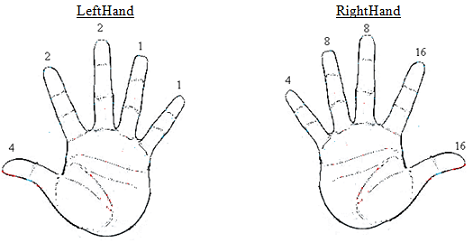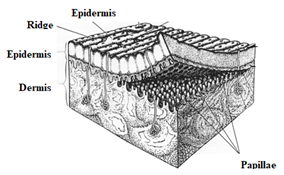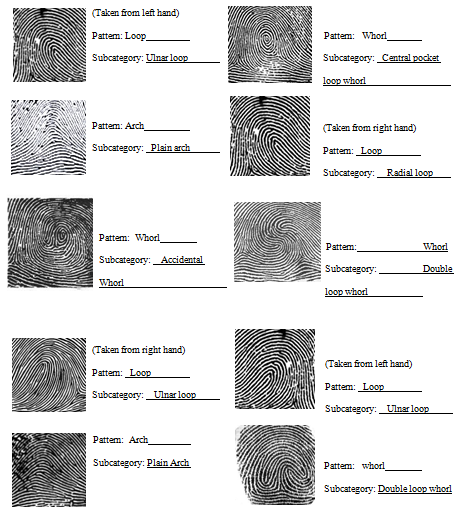ARE YOU LOOKING FOR RELIABLE HENRY-FBI CLASSIFICATION ASSIGNMENT HELP SERVICES? EXPERTSMINDS.COM IS RIGHT CHOICE AS YOUR STUDY PARTNER!
Assignment - Collecting and Analyzing Your Own Prints
You will make a fingerprint impression of each of your 10 fingers:
Materials:
- Yourfingers
- Charcoal/SoftPencil
- Transparenttape
- MagnifyingGlass
- Paper
Procedure:
1. Color a dark square of charcoal/pencil on scrap paper. Roll the "pad" portion of a finger over the square from one side of your finger to the other side of your finger. You can roll/smear your finger around. This is like "dusting" your fingerprint.
2. Carefully tear off about 2" of clear tape and lay it on your dusted finger. Press the tape down evenly and then peel it off slowly. This is like "lifting" a latent fingerprint. If you have a good print, stick the tape with your print on a piece of paper and label which finger it is. Otherwise, try again.
3. Repeat steps 1 - 2 (keep coloring over your original dark square) for your remaining fingers and stick the tapes to your paper.
4. Using a magnifying glass, record the type of fingerprint under each of your 10fingerprints.
Choices for types of fingerprints:
- RadialLoop
- UlnarLoop
- Whorl
- Central Pocket LoopWhorl
- Double LoopWhorl
- AccidentalWhorl
- Plainarch
- Tentedarch
5. Don't submit your actual fingerprints with your lab!!! They are considered your personal data. Just record how many fingers you have of each type above.
SAVE YOUR HIGHER GRADE WITH ACQUIRING HENRY-FBI CLASSIFICATION ASSIGNMENT HELP & QUALITY HOMEWORK WRITING SERVICES OF EXPERTSMINDS.COM!
Determining your Henry-FBI Classification Number
Edward Henry developed a method of classifying all sets of 10 fingerprints into 1,024 groups. This is done so that when an unknown set of prints is submitted to the FBI for comparison, most of the millions of sets on file can be weeded out, leaving only a few dozens of sets of prints that have to be compared by hand. Even with computer programs to help with comparisons, sometimes forensic scientists still need to compare by hand.
Each person's 10 fingerprints are assigned a number, which is called the Henry-FBI classification number:
Step 1: Identify the presence of any whorl patterns on your fingers. In the table below, write a yes or no in rows 1 and 4 if you have whorls on the each of the fingers listed:
|
ROW
|
Finger
|
Right Index
|
Right Ring
|
Left Thumb
|
Left Middle
|
Left Pinky
|
|
Primary Classification
|
|
1
|
Does this finger have a whorl?
|
Yes
|
Yes
|
No
|
No
|
No
|
|
|
|
2
|
Classification Number
|
16
|
8
|
0
|
0
|
0
|
1
|
24
|
|
3
|
Finger
|
Right Thumb
|
Right Middle
|
Right Pinky
|
Left Index
|
Left Ring
|
|
Primary Classification
|
|
4
|
Does this finger have a whorl?
|
No
|
No
|
Yes
|
No
|
No
|
|
|
|
5
|
Classification Number
|
0
|
0
|
4
|
0
|
0
|
1
|
4
|
Step 2: Each finger is given a different number. Examine the diagram below.
- If your finger DOES NOT have a whorl pattern, write a ZERO in rows 2 and 5 in the table above for the classification number.
- If your finger DOES have a whorl pattern write the corresponding number from the diagram below in rows 2 and 5.

DO YOU WANT TO EXCEL IN HENRY-FBI CLASSIFICATION ASSIGNMENT? HIRE TRUSTED TUTORS FROM EXPERTSMINDS AND ACHIEVE SUCCESS!
Step 3: Add up the numbers in rows 2 and 5, including the "1" that is in the 2ndto last column. Write the total in the last column of the table. This number (written as a fraction) is your Henry - FBI classification.
Your fraction: Numerator (Last column in row 2)/Denominator (Last Column in row 5) = 25/5
1. Were all your fingerprints the same type of pattern? No What patterns were they? Provide a possible explanation as to why they may vary:
A: Finger prints are formed during the fetal stage at around 3 months. They are formed due to the differential growth of the dermal papillae and the epidermal layer as the papillae have the actively dividing cells and tend to dictate the formation of the folds.
2. Examine this table, which shows the frequency of each type of fingerprint in the population as a whole.
|
Frequency of Fingerprint Patterns
|
|
Loops
|
Whorls
|
Arches
|
|
Radial
|
Ulnar
|
Plain
|
Other
|
Plain
|
Tented
|
|
5%
|
60%
|
20%
|
10%
|
4%
|
1%
|
If 60% of the population has ulnar loops, why are fingerprints considered to be individual evidence?
A: Though a majority of the population have ulnar loops as their finger print pattern the number of ulnar loops and the type of pattern in each finger and the HBI classification differs , going further the minutiae offer additional specificity to them
3. How do your fingerprints compare to the population as a whole?
A: The finger prints of my hand have a total of 30% plain whorls i.e., 3 fingers have whorls. 40% Ulnar loops i.e. 4 fingers have ulnar pattern of loops and no radial loops are observed., 30% plain arches i.e. 3 fingers have plain arches. In comparison to the general population the significant difference is the presence of more arches.
4. Why are Henry - FBI classification numbers useful to police officers and forensic scientists?
A: Henry classification is one of the oldest fingerprint classification system. According to this each finger is allotted a specific number starting from the right hand. Presence of a whorl determines the number. In the absence of a whorl a zero is given. The ratio of the numbers of odd five fingers and the even finger is considered. Earlier the it was difficult to classify the fingerprint data obtained in the police records. Henry system helped them categorize the fingerprint based on the ratio value obtained.
EXPERTSMINDS.COM ACCEPTS INSTANT AND SHORT DEADLINES ORDER FOR HENRY-FBI CLASSIFICATION ASSIGNMENT - ORDER TODAY FOR EXCELLENCE!
For each vocabulary word, match the correct definition AND example:
|
DEFINITION
|
|
VOCABULARY WORD
|
EXAMPLE
|
|
5. A fingerprint pattern with one or more ridges entering and exiting from the same side.
|
10 Fingerprint C
|
A.

|
|
6. Fingerprint made by the deposit of perspiration or body oils that is invisible to the naked eye.
|
9 Dactyloscopy H
|
B. Ridge endings, Islands, Bridges, Eye/enclosures, Cicatrix, Bifurcations and Dots.
|
|
7. A fingerprint pattern with at least two deltas and a core.
|
5 Loop J
|
C. ALL of the following:

|
|
8. The fine structure of ridge characteristics in fingerprints.
|
11 Delta A
|
D. Tented & Plain

|
|
9. The study of fingerprints.
|
7 Whorl G
|
E. Fingerprint lifted by dusting or iodine fuming.
|
|
10. An impression made by ridge patterns on the top of a finger.
|
5 Arch D
|
F. Fingerprint in clay, wax or fresh paint.
|
|
11. A triangular area found on all loop and whorl patterns.
|
8 Minutiae B
|
G. Plain,
Central Pocket, Double Loop & Accidental
|
|
12. A 3-D print made as an indentation in soft material.
|
|
13 VisiblePrint I
|
H. People who use fingerprints to help determine who committed a crime are studying this.
|
|
13. Fingerprint left by a finger that has touched something to stain it.
|
6 LatentPrint E
|
I. Fingerprint in blood, ink or paint.
|
|
14. A fingerprint pattern with no delta or core where all ridges enter from one side and exit the other.
|
12 PlasticPrint F
|
J. Ulnar and Radial

|
NEVER LOSE YOUR CHANCE TO EXCEL IN HENRY-FBI CLASSIFICATION ASSIGNMENT - HIRE BEST QUALITY TUTOR FOR ASSIGNMENT HELP!
15. List three parts of the body that have ridges andfurrows.
A: Ridges and furrows are the raised edges and the depressions observed in a fingerprint. The lips in addition to the hands and feet have them.
16. Why do fingerprints offer an evolutionary advantage?
A: Evolution is a change in the characteristics of an organism. Some of the changes offer an advantage to the organism as they enable the organisms to withstand the unfavorable conditions and perform better. Fingerprints are the skin folds with ridges and furrows formed by the dermis during the foetus formation. These ridges and furrows increase the surface area of the skin and provide firm hold on the objects thereby enhancing the organisms.
17. Label the following in the diagram below: Papillae, Dermis, Epidermis, and Ridges.

18. For each statement below, identify which part of the skin/fingerprint anatomy isdescribed. (Terms may be used more thanonce).
Possible Choices: Dermis, Epidermis, Ridges, Furrows, Papillae
Ridges Raised structures on the tips offingers
Papillae Creates the Ridges on thesurface
Epidermis Outermost layer ofskin
Dermis Layer of skin that containspapillae
Dermis Layer of skin that contains sweat glands and nervecells
Valleys White space left in fingerprintpatterns
Ridges Black space left in fingerprintpatterns
19. List TWO components left by your fingers when you touchsomething.
A: When an individual touch any object the finger tips transfer the oil, grease, oil secretions of the skin adhered to them which leave a finger print
20. Why do identical twins NOT have identical fingerprintpatterns?
A: Despite being twins the external factors contribute to the fingerprint formation and hence the identical twins may share the DNA but do not possess the identical fingerprints.
21. Compare and contrast a radial and ulnar looppattern.
A: Loops are observed in more than 60% of the population. Loops are charectirized by ridges enter pattern is the most common finding in the fingerprints of human beings. There are two types of loops observed radial and ulnar. Radial loops have their ridge endings pointing towards their thumb direction whereas the ulnar loop is the ridges are directed towards their little fingers.
ORDER NEW HENRY-FBI CLASSIFICATION ASSIGNMENT & GET 100% ORIGINAL SOLUTION AND QUALITY WRITTEN CONTENTS IN WELL FORMATS AND PROPER REFERENCING.
22. What are minutiae and why are they important inclassification?
A: Dactyloscopy involves the study of fingerprints and is useful I criminal investigation. The preliminary observation is based on the characteristic patterns such as whorl, loop and arches. However, to intensify the search and identify the individual the minutiae i.e, the minute sub-patterns observed in the fingerprint that form delta, islands, core, bifurcation are used. The variability of these minutiae in every individual is high and is almost impossible to have the similar fingerprints. Though the general pattern gives a broad idea it is the minutiae that are essential to match the fingerprints.
23. In the table below, describe the print and identify TWO objects this type of print could be foundon:
|
Type of Print
|
Description
|
Two Objects could be Found on
|
|
Plastic
|
Plastic finger prints are often found on the soap and other soft objects which only need a small amount of pressure to create an indentation that leads to the characteristic fingerprint pattern
|
Glass , soap
|
|
Visible
|
Visible finger prints are observed mostly in the crime scene with blood stains. In some other cases the ink and other colored liquids such as fresh paint leave a clear impression for the analysis.
|
Dyes, blood, paint
|
|
Latent
|
The word latent means hidden. As the name suggests the fingerprints that are not visible without further development technique are latent. The composition of latent fingerprint is usually sweat with sebum and fatty acids.
|
Wooden objects, Clothing
|
24. What is the chemical found in superglue that adheres tofingerprint?
And: Cyanoacrylate adheres to the composition of the sweat secretions permanently and thereby making the pattern of the invisible finger print clear. Unlike the other fingerprint powders the cyanoacrylate can be used for the uneven edges on the surfaces such as knives, bolts.
GET GUARANTEED SATISFACTION OR MONEY BACK UNDER HENRY-FBI CLASSIFICATION ASSIGNMENT HELP SERVICES OF EXPERTSMINDS.COM - ORDER TODAY NEW COPY OF THIS ASSIGNMENT!
25. Describe the technique and the type of surface the technique could be used on to visualize latentprints:
|
Technique
|
Description
|
Type of Surface Used On
|
|
Dusting
|
Dusting as the name suggests involves the usage of powder usually black powder to sprinkle on the suspected surface. Exploiting the adherence nature of the powder to the oily secretion of the skin in the fingerprint. Dust adhere only to a selected component of the secretions and hence is not a reliable methods for developing the old prints.
|
glass and wood and Plastic
|
|
Iodine Fuming
|
Iodine fumes are exposed to the target surface with the latent finger prints. The iodine molecules adsorb to the oil and the fatty acid esters and change color. This is a temporary method.
|
Plastic, paper and glass
|
|
Ninhydrin
|
Ninhydrin is routinely used in biochemical laboratories known for its capacity to bind to the amino acids and turn into a color complex making its easier to identify the presence of amino acids. However in this case this aids in the characteristics pattern of the fingerprint.
|
Porous substances clothing paper tissue and
|
|
Silver Nitrate
|
Silver nitrate forms a colloid with the substances in the fingerprint. The silver nitrate solution is sprayed onto crime scene surface for its to eventually develop into a pattern.
|
|
|
Superglue Fuming
|
Cyanoacrylate is the major component of super glue. The surfaces are subjected to the fumes of cyanoacrylate to develop the latent prints. The compound is known for its affinity towards the fatty acids, amino acids.
|
Door nobs, furniture..
|
DO WANT TO HIRE TUTOR FOR ORIGINAL HENRY-FBI CLASSIFICATION ASSIGNMENT SOLUTION? AVAIL QUALITY HENRY-FBI CLASSIFICATION ASSIGNMENT WRITING SERVICE AT BEST RATES!
26. For each fingerprint below, identify the PATTERN (Whorl, Loop, or Arch) and SUBCATEGORY of the fingerprint shown (Radial, Plain, etc). Patterns and subcategories may be used more thanonce.
** Remember that PRINTS are MIRROR IMAGES of what is actually on the FINGER on the BODY!

GETTING STUCK WITH SIMILAR HENRY-FBI CLASSIFICATION ASSIGNMENT? ENROL WITH EXPERTSMINDS'S HENRY-FBI CLASSIFICATION ASSIGNMENT HELP SERVICES AND GET DISTRESSED WITH YOUR ASSIGNMENT WORRIES!